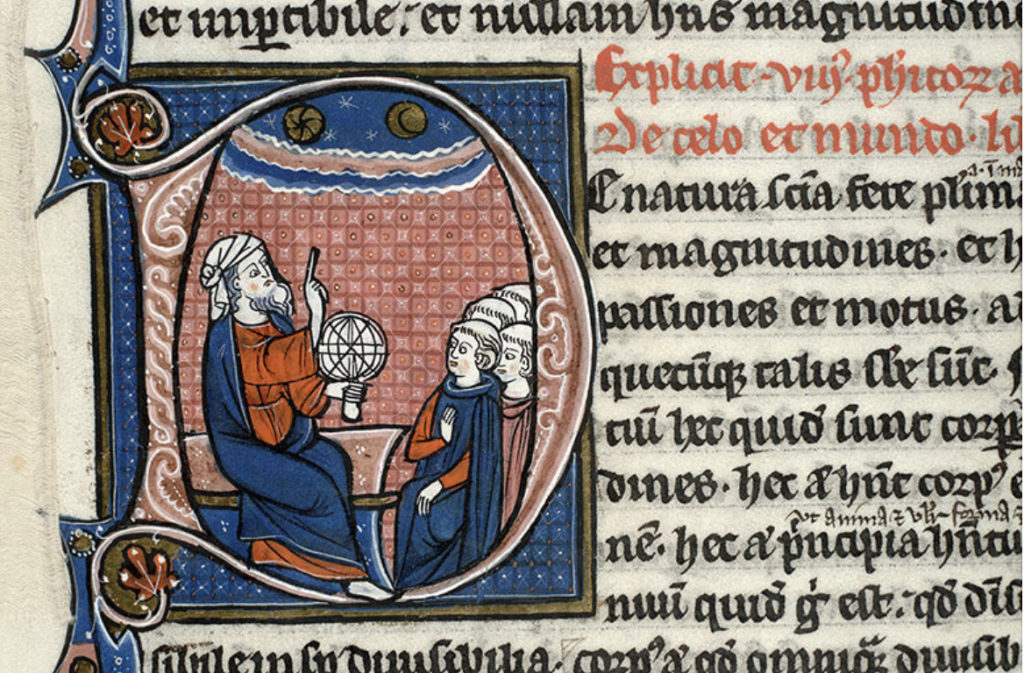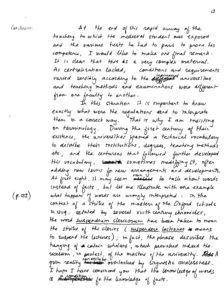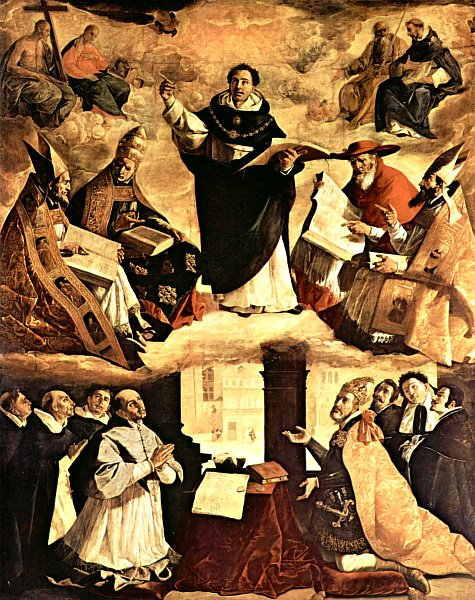Another way of studying these methods is to take a specific example, where the attention to the method is combined with the study of the text itself. I tried to do this in a paper I presented at a conference (the first international conference of the “Societas Artistarum”) organised at the Warburg Institute in London, under the title: Adam of Buckfield’s Commentary on “De anima”. The text of the paper follows here: Adam of Buckfield’s Commentary on De anima. A Case Study
Detail from a manuscript of Adam of Buckfield’s commentary on De celo et mundo
Finally, I also gave some lectures and conferences on the theme of teaching methods. The first one was in California, where Richard Rouse had invited me for a visit. At the UCLA I gave a paper on medieval lexicography (see article n° 20). At Stanford University, on the invitation of George Brown, I gave a public lecture under the title “Teaching methods and examinations in medieval universities”; finally I gave a short talk at Berkeley at the weekly luncheon of the medieval studies faculty on the denominations of masters and other teachers (a paper I recycled later for a volume in honour of A.J. de Groot; see article n° 14).
The lecture at Stanford has not been printed as such, because it consisted of materials for my monographies. The form of my notes for the lecture has a historical interest: they are handwritten, on lined A4 sheets, include corrections and underlining, references in the margins, and the A4 sheets are mingled with smaller ones on which I had copied passages, translated into Engish, of by book Terminologie des universités au XIIIe siècle (see Book n° 6). At the end of the lecture I insisted on the necessary knowledge of technical terms for the correct interpretation of texts. Here is the last page:
The paper was in fact an illustration of the study of intellectual vocabulary applied to the field of teaching methods an examinations.
Many years later, in 2011, I had the opportunity to give a talk at a seminar on “la description des pratiques de savoir” in the context of the European project SAW (UMR SPHERE, CNRS & Univ. Paris 7), organised by Karine Chemla. My paper was entitled “Practice of Knowledge in Medieval Universities”. As the paper is a kind of survey of my research for a large public and repeats passages from my publications, I just reproduce here the ‘résumé’ I sent in before the conference:
The practice of knowledge in Medieval Universities
Short introduction
The first universities originated in Bologna and Paris around 1200; soon afterwards followed Oxford and Cambridge, Toulouse, Montpellier, etc. In most cases the universities were spontaneous creations of masters and students, creating a corporation to defend their rights and organisation. In some cases, a university was created by an authority, like the one of Naples by emperor Frederic II. Later universities followed the model either of Bologna or of Paris; the last especially in Northern and Central Europe, where many universities were created in Germany, Poland, Austria, in the 14th and 15th centuries.
As for learning in the various faculties: in the Faculty of Arts the “liberal arts” (grammar, dialectic, rhetoric, astronomy, geometry, mathematics, music), but essentially logic and philosophy based on the works of Aristotle; theology, law, and medicine in the higher faculties. The most complete form, comprising four faculties, existed for instance in Paris.
In all the faculties the same methods of teaching and research were applied, and mostly the same kind of exercise and examination; so, the practice of knowledge in the four faculties was very similar, apart from the doctrinal contents.
Interaction between the faculties was current: generally, students had to attend to the Faculty of arts before going on to the higher faculties (with some exceptions, namely the schools of the Mendicant orders, and jurists in Italy). The students were already familiar with the methods of teaching and research before doing theology, law or medicine.
Interaction between university scholars and the outside world naturally also existed: in theology a permanent link with church administration, in law studies a narrow link with jurists in law courts and probably in medicine a link with medical practitioners.
Teaching methods
The principal methods of teaching were the lectio, a commented reading of the basic texts, and the disputatio, a discussion structured around questions that may have arisen either from the texts or independently from them. A third method, the qu(a)estio or question asked on the texts was originally an element of the lectio and to a degree continued to be a part of it.
The method of the lectio evolved over time, especially within the context of university teaching. In the13th century, three types of commentaries can be distinguished: those in the form of lectiones (exposition of the text followed by short questions), the commentaries in the form of questiones (disputed questions) and a third type in the form of sententia (a paraphrase interspersed with notes and small questions).
When the questions are detached from the text and are treated in a separate discussion during a special session outside the lectio, we encounter the disputatio and the resulting text – through reportatio (written report) or redaction – constitutes a ‘questio disputata’. This questio disputata is thus in principle separate from the teaching of a text and is the subject of a disputatio, that is an elaborate and regulated discussion in which the master and several other persons intervene, one being the ‘opponent’ and the other (or several others) ‘respondent’.
Among the disputations two types must be distinguished: the disputatio in scolis, or private disputation, which took place in the masters’ schools with their own pupils, on ‘disputation-days’ (those days during which disputations were authorised) and at the usual times. This private disputation was principally an exercise for students. Besides this, there was the disputatio sollempnis or disputatio magistrorum for which were usually assembled all the masters and students of the Faculty.
Around 1300, questions that were the object of disputations did no longer deal solely with problems of logic but also with wider-ranging issues, metaphysical or psychological in nature. Clearly, disputations of this type were then no longer exercises in the art of debate but constituted true instruments of research which assisted in resolving difficult problems.
This implied sometimes conflicts between the faculties. A well known case is the condemnation of a list of “errors”, in 1270 and 1277, when the bishop of Paris, Etienne Tempier, at the instigation of the masters of theology, promulgated the condemnation of 13 philosophical or theological propositions (1270) concerning the eternity of the world, the negation of divine providence, the unicity of the intellective soul for all men (monopsychism), and determinism (free will). Then, in 1277, he formulated another condemnation, in a new decree of 219 articles. The condemnations were directed against the philosophers of the Faculty of arts in Paris, essentially Siger of Brabant and Boethius of Dacia, representing a current of thought called Latin Averroism (because they adhered to the ideas of Averroes) or radical Aristotelianism.
Bishop Etienne Tempier
Special features of university education
The disputation had a central place: analysis of problems was certainly an old method of research – see for instance Plato’s dialogues -, but if we take the term disputation in the specific sense of scholastic method, its pedagogical aspect and the one of investigation seem to go in pair. In medieval reflections on the disputation we often find them together.
However, the most interesting aspect of the disputation was undoubtedly the function of research. The attempt to gain knowledge in complicated matters by way of the disputation was at the origin of the collective research conducted by several masters and students during the solemn, public disputations. Later, the system was adopted by individual scholars for investigation of problems in their treatises.
The “investigation of the truth” is a recurrent theme in the reflections on the disputation. Analysis of problems and search for the truth were thus one of the main features of university teaching. Often, they were accompanied by open-mindedness and modesty. In fact, the idea of coming nearer to the truth without necessarily attaining it is present in various writers from the end of the 13th and the 14th century. They consider the disputation as a tool to take a step on the way to the truth, not to establish it without any doubt. This surprisingly open-minded approach is found not only in the circles of the philosophers, but also in those of the jurists and the teachers of medicine. In the Faculty of theology, it could occur on the level of details, but it found its limits in orthodoxy.
Later developments of the universities brought significant changes, but the basic methods, lecture and disputation, continued to be in use for a long time.
This general account leads us on to the main topic of my further research, which is the next section of this website: III, 3 Disputation Techniques.



Commentaires récents